
|
Now it is bright as 8.4 mag (Oct. 23, Marco Goiato). It is observable at 8 mag for a long time from 2022 to 2023. In the Southern Hemisphere, it stays observable for a long time, although it becomes low temporarily from November to December. In the Northern Hemisphere, it is not observable until 2023 summer.
Date(TT) R.A. (2000) Decl. Delta r Elong. m1 Best Time(A, h)
Nov. 12 16 35.03 -46 27.4 2.595 1.861 34 8.1 20:17 ( 43, 15)
Nov. 19 16 45.61 -48 53.3 2.592 1.839 32 8.1 20:26 ( 38, 13)
|
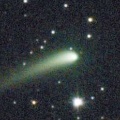
|
Now it is bright as 10.2 mag (Nov. 3, Ken-ichi Kadota). It will approach to Earth down to 0.29 a.u. in 2023 February, and it is expected to brighten up to 5 mag. In the Northern Hemisphere, it stays observable in excellent condition for a long time, although it becomes extremely low temporarily in November. In the Southern Hemisphere, it is not observable until early February.
Date(TT) R.A. (2000) Decl. Delta r Elong. m1 Best Time(A, h)
Nov. 12 15 50.03 24 25.3 2.039 1.482 43 10.3 20:17 ( 96,-36)
Nov. 19 15 50.67 24 23.8 1.950 1.414 43 10.0 20:26 ( 92,-43)
|
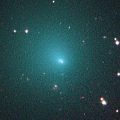
|
Now it is very bright as 9.7 mag (Oct. 23, Marco Goiato). It stays 10 mag until November. In the Northern Hemisphere, it becomes unobservable soon. In the Southern Hemisphere, it becomes unobservable temporarily from December to January.
Date(TT) R.A. (2000) Decl. Delta r Elong. m1 Best Time(A, h)
Nov. 12 19 54.60 -40 53.7 1.754 1.609 65 10.4 20:17 ( 65, 45)
Nov. 19 19 45.15 -40 16.9 1.912 1.600 56 10.5 20:26 ( 63, 37)
|
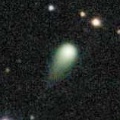
|
Now it is 11.6 mag (Nov. 2, Osamu Miyazaki). It is expected to brighten up to 10 mag in 2023. In the Northern Hemisphere, it stays observable in good condition until 2023 autumn. In the Southern Hemipshere, it stays unobservable until 2023 summer.
Date(TT) R.A. (2000) Decl. Delta r Elong. m1 Best Time(A, h)
Nov. 12 11 11.69 64 26.1 2.760 2.987 93 11.0 3:12 (206,-23)
Nov. 19 11 13.02 67 27.7 2.615 2.937 99 10.8 3:04 (202,-23)
|
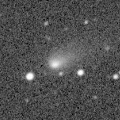
|
Now it is 11.4 mag (Oct. 29, Osamu Miyazaki). Appearing in the morning sky also in the Southern Hemisphere. It stays 11-12 mag until spring.
Date(TT) R.A. (2000) Decl. Delta r Elong. m1 Best Time(A, h)
Nov. 12 12 14.02 -0 32.2 2.160 1.633 45 11.7 3:12 (267, 5)
Nov. 19 12 33.22 -2 24.7 2.110 1.620 47 11.6 3:04 (269, 6)
|

|
It brightened up to 8.3 mag in last winter (Jan. 6, Toshiyuki Takahashi). Now it is fading. But it is bright as 11.1 mag still now (Nov. 2, Ken-ichi Kadota).
Date(TT) R.A. (2000) Decl. Delta r Elong. m1 Best Time(A, h)
Nov. 12 9 56.05 -20 33.3 4.676 4.486 72 11.6 3:12 (266, 44)
Nov. 19 9 58.18 -22 5.7 4.625 4.523 77 11.7 3:04 (265, 48)
|
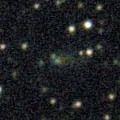
|
Now it is 13.8 mag (Nov. 5, Ken-ichi Kadota). It stays bright as 11-12 mag until January, and it is observable in excellent condition. It is a bit fainter than this ephemeris.
Date(TT) R.A. (2000) Decl. Delta r Elong. m1 Best Time(A, h)
Nov. 12 8 10.98 8 38.0 1.294 1.832 105 11.8 3:12 (212, 41)
Nov. 19 8 20.21 8 8.1 1.232 1.830 110 11.7 3:04 (209, 42)
|

|
Now it is 13.8 mag (Oct. 15, Chris Wyatt). It is expected to brighten up to 11 mag in 2023. In the Northern Hemisphere, it will be unobservable in November. In the Southern Hemisphere, it stays observable in good condition for a long time, although it becomes unobservable temporarily from November to January.
Date(TT) R.A. (2000) Decl. Delta r Elong. m1 Best Time(A, h)
Nov. 12 17 38.49 -16 47.2 4.276 3.525 36 12.3 20:17 ( 76, 9)
Nov. 19 17 43.94 -18 3.8 4.311 3.493 30 12.2 20:26 ( 70, 3)
|

|
Now it is 14.7 mag (Oct. 26, Michael Jager). It is expected to brighten up to 12 mag from winter to summer in 2023. In the Northern Hemisphere, it stays observable in good condition until 2023 spring. In the Southern Hemisphere, it stays observable in good condition for a long time after this. It is fainter than this ephemeris recently.
Date(TT) R.A. (2000) Decl. Delta r Elong. m1 Best Time(A, h)
Nov. 12 4 48.42 20 18.8 1.905 2.838 155 12.9 1:27 (180, 35)
Nov. 19 4 38.31 17 16.9 1.818 2.785 165 12.7 0:49 (180, 38)
|
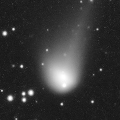
|
Now it is bright as 12.8 mag (Aug. 28, Hiroshi Abe). It stays 12 mag for a while. It becomes unobservable from August to November in the Northern Hemisphere, or from September to December in the Southern Hemisphere.
Date(TT) R.A. (2000) Decl. Delta r Elong. m1 Best Time(A, h)
Nov. 12 14 16.41 -2 55.6 5.358 4.435 19 12.8 3:12 (288,-19)
Nov. 19 14 23.96 -2 47.6 5.336 4.453 24 12.8 3:04 (286,-16)
|
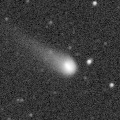
|
Now it is 13.7 mag (Sept. 24, Hiroshi Abe). It is expected to brighten up to 12 mag in 2023. In the Northern Hemisphere, it stays observable in good condition for a long time, although it became unobservable temporarily in October. In the Southern Hemisphere, it is not observable until mid December. But it will be observable in good condition in 2023.
Date(TT) R.A. (2000) Decl. Delta r Elong. m1 Best Time(A, h)
Nov. 12 13 46.04 9 27.0 4.616 3.831 33 13.2 3:12 (272,-20)
Nov. 19 13 48.05 8 30.1 4.535 3.811 38 13.2 3:04 (271,-16)
|
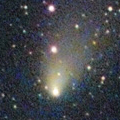
|
It brightened up to 10.4 mag from June to July (July 22, Ken-ichi Kadota). Appearing in the morning sky in the Souther Hemisphere. It will never be observable again in the Northern Hemisphere.
Date(TT) R.A. (2000) Decl. Delta r Elong. m1 Best Time(A, h)
Nov. 12 14 31.12 -54 21.4 2.632 1.942 37 13.2 3:12 (328, 14)
Nov. 19 14 58.25 -56 55.1 2.705 2.024 38 13.5 3:04 (331, 15)
|
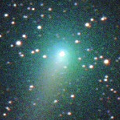
|
It brightened up to 9.3 mag in early summer (June 5, Chris Wyatt). Now it is fading. It has already faded down to 14.6 mag (Oct. 29, Chris Wyatt). In the Southen Hemisphere, it stays observable in good condition for a long time. It became observable also in the Northern Hemisphere. But it stays locating low for a while.
Date(TT) R.A. (2000) Decl. Delta r Elong. m1 Best Time(A, h)
Nov. 12 10 2.11 -42 18.2 2.800 2.601 68 13.3 3:12 (297, 49)
Nov. 19 9 55.45 -42 53.4 2.767 2.661 73 13.4 3:04 (297, 54)
|

|
Now it is 13.6 mag (Oct. 23. Toshihiko Ikemura, Hirohisa Sato).
Date(TT) R.A. (2000) Decl. Delta r Elong. m1 Best Time(A, h)
Nov. 12 6 58.03 29 11.0 5.403 6.042 126 13.5 3:12 (186, 26)
Nov. 19 6 56.48 29 15.0 5.320 6.044 133 13.5 3:04 (181, 26)
|
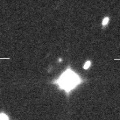
|
Now it is 14.3 mag (Oct. 15, Ken-ichi Kadota). It is expected to brighten up to 12.5 mag in winter. In the Northern Hemisphere, it will be observable in good condition after this. In the Southern Hemisphere, it is not observable until 2023 June.
Date(TT) R.A. (2000) Decl. Delta r Elong. m1 Best Time(A, h)
Nov. 12 12 56.76 24 26.6 2.594 2.144 52 14.4 3:12 (252,-18)
Nov. 19 13 10.67 26 29.4 2.446 2.094 57 14.2 3:04 (250,-18)
|
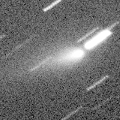
|
Outburst occured in early October. Now it is very bright as 10.4 mag (Oct. 15, Chris Wyatt). It stays observable in good condition in the Southern Hemisphere. It locates low in the Northern Hemisphere. Michael Jager detected several fragments at 17.5-19 mag.
Date(TT) R.A. (2000) Decl. Delta r Elong. m1 Best Time(A, h)
Nov. 12 20 42.19 -30 52.1 1.314 1.440 75 14.5 20:17 ( 84, 53)
Nov. 19 21 9.95 -28 36.1 1.409 1.503 75 14.9 20:26 ( 86, 50)
|

|
Now it is 14.7 mag (Oct. 31, ATLAS South Africa). It stays observable at 13-14 mag for a while.
Date(TT) R.A. (2000) Decl. Delta r Elong. m1 Best Time(A, h)
Nov. 12 19 36.78 -29 0.2 3.440 3.104 62 14.5 20:17 ( 79, 39)
Nov. 19 19 46.85 -28 30.7 3.530 3.111 57 14.6 20:26 ( 76, 33)
|
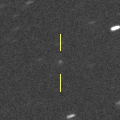
|
It will brighten up to 13 mag in winter. But the condition is bad. It is not observable until February in the Southern Hemisphere, or until May in the Northern Hemisphere.
Date(TT) R.A. (2000) Decl. Delta r Elong. m1 Best Time(A, h)
Nov. 12 15 4.95 -16 7.3 2.717 1.727 1 14.7 3:12 (306,-19)
Nov. 19 15 24.11 -17 45.5 2.689 1.703 3 14.5 3:04 (307,-17)
|
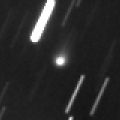
|
Now it is 14.5 mag (Oct. 29, Chris Wyatt). It stays 14 mag in 2023. In the Southern Hemisphere, it stays observable in good condition for a long time. It locates somewhat low in the Northern Hemisphere.
Date(TT) R.A. (2000) Decl. Delta r Elong. m1 Best Time(A, h)
Nov. 12 5 41.06 -22 51.2 3.073 3.728 124 14.7 2:19 (180, 78)
Nov. 19 5 26.15 -23 39.7 2.990 3.697 129 14.6 1:36 (180, 79)
|
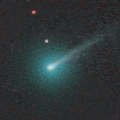
|
It brightened rapidly up to 12.4 mag in early October (Oct. 2, Michael Jager). Then it became fainter a bit, 13.3 mag (Oct. 26, Ken-ichi Kadota). Although it is a tiny comet, it approached to Sun down to 0.63 a.u. on Oct. 25. It is not observable after this.
Date(TT) R.A. (2000) Decl. Delta r Elong. m1 Best Time(A, h)
Nov. 12 14 45.94 3 21.9 1.562 0.737 21 14.6 3:12 (287,-28)
Nov. 19 15 10.38 -1 23.8 1.689 0.820 18 15.3 3:04 (292,-26)
|

|
Now it is 15.1 mag (Oct. 26, Thomas Lehmann). The brightness evolution is slower than originally expected. It stays 14-15 mag for a long time. Now it is not observable. It will be observable in early January in the Northern Hemisphere, or in early February in the Southern Hemisphere.
Date(TT) R.A. (2000) Decl. Delta r Elong. m1 Best Time(A, h)
Nov. 12 17 8.10 -20 36.6 3.841 3.010 28 14.8 20:17 ( 68, 5)
Nov. 19 17 13.01 -19 26.6 3.910 3.024 22 14.8 20:26 ( 65, -2)
|
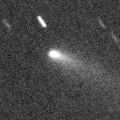
|
Now it is 14.8 mag (Oct. 25, Michael Jager). It stays 15 mag and observable in excellent condition until December.
Date(TT) R.A. (2000) Decl. Delta r Elong. m1 Best Time(A, h)
Nov. 12 2 16.15 23 7.9 1.448 2.423 166 15.1 22:50 (180, 32)
Nov. 19 2 10.17 23 56.2 1.475 2.426 159 15.2 22:16 (180, 31)
|
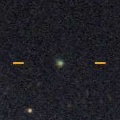
|
Now it is 15.3 mag (Oct. 29, Chris Wyatt). It is expected to brighten up to 8 mag in 2023 July. In 2022, it stays observable in good condition while the comet will be brightening gradually.
Date(TT) R.A. (2000) Decl. Delta r Elong. m1 Best Time(A, h)
Nov. 12 1 51.66 -9 16.2 2.724 3.597 147 15.2 22:25 (180, 64)
Nov. 19 1 38.10 -10 28.8 2.728 3.529 138 15.2 21:44 (180, 65)
|
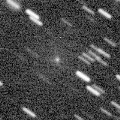
|
Now it is 16.1 mag (Nov. 2, Michael Jager). It brightens up to 13 mag in January. In the Northern Hemisphere, it stays observable in excellent condition. In the Southern Hemisphere, it is not observable until February.
Date(TT) R.A. (2000) Decl. Delta r Elong. m1 Best Time(A, h)
Nov. 12 18 54.85 67 37.7 1.199 1.615 94 15.5 20:17 (156,-26)
Nov. 19 18 53.30 67 18.9 1.142 1.561 93 15.2 20:26 (154,-29)
|
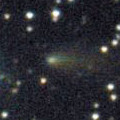
|
Now it is 14.7 mag (Nov. 5, Ken-ichi Kadota). It stays observable in good condition at 15 mag from summer to winter. It locates somwwhat low in the Southern Hemisphere.
Date(TT) R.A. (2000) Decl. Delta r Elong. m1 Best Time(A, h)
Nov. 12 8 1.77 19 3.2 1.881 2.414 110 15.3 3:12 (205, 32)
Nov. 19 8 5.49 19 10.7 1.815 2.427 116 15.2 3:04 (200, 33)
|

|
Now it is 14.8 mag (Oct. 29, Chris Wyatt). It was expected to brighten up to 13 mag in spring. But actually, it was fainter than originally expected. In the Southern Hemisphere, it stays observable in good condition for a long time. In the Northern Hemisphere, it stays extremely low for a while.
Date(TT) R.A. (2000) Decl. Delta r Elong. m1 Best Time(A, h)
Nov. 12 4 31.73 -53 40.0 3.023 3.438 106 15.3 1:10 ( 0, 71)
Nov. 19 4 8.90 -53 2.4 3.042 3.466 107 15.4 0:20 ( 0, 72)
|
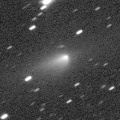
|
It brightened up to 12.7 mag in early 2022 (Feb. 27, Toshihiko Ikemura, Hirohisa Sato). Now it is fading. Now it is not observable. It will be observable agin at 16 mag in January in the Southern Hemisphere, or in February in the Northern Hemisphere.
Date(TT) R.A. (2000) Decl. Delta r Elong. m1 Best Time(A, h)
Nov. 12 15 19.92 -19 48.4 3.332 2.345 3 15.4 20:17 ( 52,-14)
Nov. 19 15 34.76 -20 46.4 3.350 2.362 1 15.5 3:04 (312,-17)
|
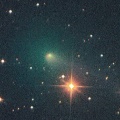
|
Now it is 14.8 mag (Oct. 20, Toshihiko Ikemura, Hirohisa Sato). It stays observable in good condition after this. But it will be fading gradually after this.
Date(TT) R.A. (2000) Decl. Delta r Elong. m1 Best Time(A, h)
Nov. 12 0 48.34 -2 17.4 1.819 2.658 140 15.5 21:22 (180, 57)
Nov. 19 0 46.76 -2 10.5 1.925 2.700 133 15.8 20:53 (180, 57)
|

|
The condition is worst in this apparition. It is not observable at all.
Date(TT) R.A. (2000) Decl. Delta r Elong. m1 Best Time(A, h)
Nov. 12 16 31.59 -17 11.5 2.196 1.312 20 15.6 20:17 ( 66, -3)
Nov. 19 16 57.55 -18 13.4 2.258 1.365 19 16.2 20:26 ( 64, -5)
|
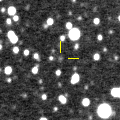
|
Now it is 15.9 mag (Nov. 5, Ken-ichi Kadota). It will brighten up to 13 mag from 2024 to 2025.
Date(TT) R.A. (2000) Decl. Delta r Elong. m1 Best Time(A, h)
Nov. 12 9 11.26 -33 34.8 7.146 7.035 79 15.8 3:12 (279, 58)
Nov. 19 9 12.88 -34 22.4 7.038 7.000 83 15.7 3:04 (279, 62)
|
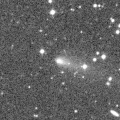
|
Now it is 14.8 mag (Oct. 25, Michael Jager). It stays 15 mag until November, and it stays observable in good condition.
Date(TT) R.A. (2000) Decl. Delta r Elong. m1 Best Time(A, h)
Nov. 12 1 16.73 -0 22.1 1.229 2.131 147 15.7 21:51 (180, 55)
Nov. 19 1 16.24 -0 25.6 1.278 2.135 140 15.8 21:23 (180, 55)
|
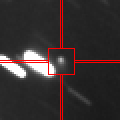
|
Now it is 15.7 mag (Nov. 2, Ken-ichi Kadota). It is expected to brighten up to 7 mag in early 2024. In the Southern Hemisphere, it stays observable in good condition for a long time. In the Northern Hemisphere, it stays low in 2022.
Date(TT) R.A. (2000) Decl. Delta r Elong. m1 Best Time(A, h)
Nov. 12 6 16.23 -34 2.1 5.092 5.534 111 16.0 2:53 (180, 89)
Nov. 19 6 13.21 -35 2.4 4.992 5.470 114 15.9 2:23 ( 0, 90)
|
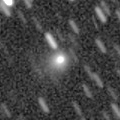
|
It brightened by 6 mag in outburst in early August up to 14.6 mag (Aug. 13, ATLAS-MLO, Mauna Loa). It is bright as 16.2 mag still now (Nov. 10, G. Lehmann, A. Salewski). It seems to stay 16 mag for a while. It stays observable in good condition for a while.
Date(TT) R.A. (2000) Decl. Delta r Elong. m1 Best Time(A, h)
Nov. 12 20 3.94 -6 30.1 1.856 1.830 72 16.0 20:17 (107, 33)
Nov. 19 20 20.03 -7 17.7 1.894 1.807 69 16.0 20:26 (102, 29)
|
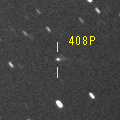
|
Now it is 16.3 mag (Nov. 7, ATLAS-MLO, Mauna Loa). It will be observable at 16-17 mag in excellent condition from autumn to winter.
Date(TT) R.A. (2000) Decl. Delta r Elong. m1 Best Time(A, h)
Nov. 12 4 29.14 0 28.7 2.558 3.472 153 16.1 1:07 (180, 54)
Nov. 19 4 25.21 -0 11.1 2.543 3.474 157 16.0 0:35 (180, 55)
|
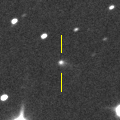
|
Now it is 16.4 mag (Nov. 10, ATLAS-HKO, Haleakala). It stays 16 mag and observable in good condition until spring.
Date(TT) R.A. (2000) Decl. Delta r Elong. m1 Best Time(A, h)
Nov. 12 9 12.20 16 39.6 3.262 3.472 93 16.2 3:12 (223, 26)
Nov. 19 9 17.91 16 51.0 3.151 3.456 99 16.1 3:04 (219, 28)
|
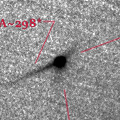
|
Due to the DART spacecraft impact to its satellite Dimorphos on Sept. 26, the cometary activity was detected. It brightened up to 12.9 mag (Sept. 28, John Drummond). It is fading after that. It has already faded down to 15.9 mag (Oct. 29, Katsumi Yoshimoto). It stays observable in good condition for a while.
Date(TT) R.A. (2000) Decl. Delta r Elong. m1 Best Time(A, h)
Nov. 12 8 10.40 12 18.2 0.134 1.037 107 16.3 3:12 (210, 38)
Nov. 19 8 19.04 15 37.9 0.149 1.055 112 16.4 3:04 (205, 36)
|
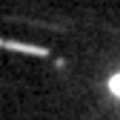
|
Now it is 17.3 mag (Nov. 10, J. Nicolas, J.-G. Bosch, F. Kugel). It will brighten rapidly up to 14 mag in spring. In the Southern Hemisphere, it will appear in the morning sky in December, and it will be observable in excellent condition in spring. In the Northern Hemisphere, it is observable in good condition in winter, but it becomes somewhat low in spring.
Date(TT) R.A. (2000) Decl. Delta r Elong. m1 Best Time(A, h)
Nov. 12 12 36.39 5 15.0 3.148 2.526 43 16.5 3:12 (266, -3)
Nov. 19 12 46.81 3 39.7 3.069 2.510 47 16.4 3:04 (266, 0)
|
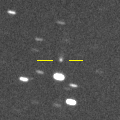
|
Now it is 17.7 mag (July 9, ATLAS Chile). It will brighten up to 16 mag in 2023. In the Southern Hemisphere, it stays observable in good condition for a long time, although it became low temporarily from August to October. In the Northern Hemisphere, it will never be observable again.
Date(TT) R.A. (2000) Decl. Delta r Elong. m1 Best Time(A, h)
Nov. 12 12 45.50 -45 47.8 4.043 3.356 40 16.8 3:12 (311, 23)
Nov. 19 12 58.24 -47 49.8 3.997 3.339 42 16.7 3:04 (312, 25)
|
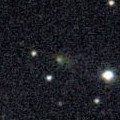
|
Now it is 16.4 mag (Nov. 5, Hirohisa Sato). It will be observable at 16-17 mag in good condition from summer to autumn.
Date(TT) R.A. (2000) Decl. Delta r Elong. m1 Best Time(A, h)
Nov. 12 3 16.69 26 11.7 1.607 2.589 171 16.8 23:50 (180, 29)
Nov. 19 3 10.68 25 35.1 1.635 2.617 171 16.8 23:17 (180, 29)
|

|
It brightened up to 14 mag in 2021. Now it is fading. It has already faded down to 16.6 mag (Oct. 26, Thomas Lehmann). It is observable at 16-17 mag in 2022.
Date(TT) R.A. (2000) Decl. Delta r Elong. m1 Best Time(A, h)
Nov. 12 23 18.08 15 1.2 5.805 6.426 125 16.9 20:17 (172, 40)
Nov. 19 23 16.89 15 0.4 5.937 6.465 118 17.0 20:26 (161, 38)
|
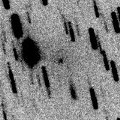
|
Now it is 17.6 mag (Oct. 25, Michael Jager). Tiny comet, but it will approach to Sun down to 0.8 a.u. in January, and to Earth down to 0.6 a.u. in March. It will brighten up to 14 mag from January to March. In the Southern Hemisphere, it stays observable in good condition for a long time. In the Northern Hemisphere, it is observable only until early Decemebr. Then it will become observable again in early March.
Date(TT) R.A. (2000) Decl. Delta r Elong. m1 Best Time(A, h)
Nov. 12 20 11.57 -24 48.1 1.504 1.499 70 17.1 20:17 ( 88, 44)
Nov. 19 20 15.05 -28 9.3 1.532 1.407 63 16.9 20:26 ( 79, 38)
|
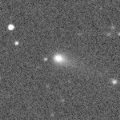
|
Now it is 16.6 mag (Oct. 26, ATLAS-MLO, Mauna Loa). It continued brightening even after the perihelion passage. It stays observable at 16 mag in good condition for a while.
Date(TT) R.A. (2000) Decl. Delta r Elong. m1 Best Time(A, h)
Nov. 12 22 57.62 -3 40.8 3.872 4.382 114 16.9 20:17 (159, 57)
Nov. 19 22 59.02 -3 39.0 3.985 4.395 108 17.0 20:26 (145, 53)
|
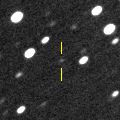
|
Now it is 17.3 mag (Oct. 30, ATLAS Chile). It is expected to brighten up to 12-13 mag from 2024 to 2025.
Date(TT) R.A. (2000) Decl. Delta r Elong. m1 Best Time(A, h)
Nov. 12 10 34.33 -19 16.1 7.086 6.717 64 17.0 3:12 (270, 35)
Nov. 19 10 34.48 -19 29.3 6.938 6.672 70 16.9 3:04 (267, 39)
|

|
Now it is 15.8 mag (Oct. 19, Toshihiko Ikemura, Hirohisa Sato). It brightened up to 14 mag from 2020 to 2021. Now it is fading slowly. It is observable at 16-17 mag in 2022.
Date(TT) R.A. (2000) Decl. Delta r Elong. m1 Best Time(A, h)
Nov. 12 0 5.61 -19 14.7 3.467 4.081 122 17.1 20:40 (180, 74)
Nov. 19 0 4.53 -18 45.4 3.572 4.098 115 17.2 20:26 (168, 73)
|

|
It brightened very rapidly up to 15.5 mag from last autumn to last winter (Nov. 2, 2021, Toshihiko Ikemura, Hirohisa Sato). Now it is fading slowly. It has already faded down to 16.5 mag (Oct. 25, Toshihiko Ikemura, Hirohisa Sato).
Date(TT) R.A. (2000) Decl. Delta r Elong. m1 Best Time(A, h)
Nov. 12 6 48.85 11 2.8 3.681 4.339 126 17.1 3:12 (185, 44)
Nov. 19 6 47.43 10 40.4 3.622 4.358 133 17.1 2:57 (180, 44)
|
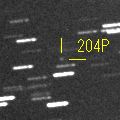
|
Now it is 17.6 mag (Nov. 6, ATLAS-HKO, Haleakala). It will brighten rapidly, and it will be observable at 16 mag in good condition in winter.
Date(TT) R.A. (2000) Decl. Delta r Elong. m1 Best Time(A, h)
Nov. 12 9 10.43 15 26.7 1.480 1.835 93 17.3 3:12 (223, 28)
Nov. 19 9 23.09 14 58.3 1.416 1.834 97 17.1 3:04 (222, 29)
|
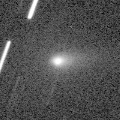
|
It brightened rapidly as predicted, and it brightened up to 14.0 mag in September (Sept. 22, Michael Jager). Now it is fading. It has already faded down to 16.4 mag (Nov. 3, ATLAS Chile). It will be fainter than 18 mag in December.
Date(TT) R.A. (2000) Decl. Delta r Elong. m1 Best Time(A, h)
Nov. 12 2 15.05 -39 55.6 0.977 1.714 121 17.1 22:49 ( 0, 85)
Nov. 19 2 15.40 -40 0.9 1.049 1.744 117 17.4 22:22 ( 0, 85)
|
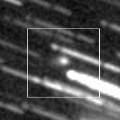
|
Now it is 16.8 mag (Nov. 8, Ken-ichi Kadota). It is expected to brighten up to 11-12 mag in 2024. In the Northern Hemisphere, it stays observable in good condition for a long time until 2023 autumn, although it becomes temporarily low in December. In the Southern Hemisphere, it is not observable until February. But it will be observable in excellent condition at the high light.
Date(TT) R.A. (2000) Decl. Delta r Elong. m1 Best Time(A, h)
Nov. 12 17 58.99 18 20.8 5.903 5.403 55 17.2 20:17 (107, -7)
Nov. 19 18 0.91 17 35.5 5.914 5.351 51 17.1 20:26 (102,-14)
|

|
Now it is 16.7 mag (Oct. 29, ATLAS-MLO, Mauna Loa). Fading slowly. In the Northern Hemisphere, it stays observable in good condition for a long time. In the Southern Hemisphere, it is not observable after this.
Date(TT) R.A. (2000) Decl. Delta r Elong. m1 Best Time(A, h)
Nov. 12 17 22.29 62 47.9 9.545 9.502 84 17.2 20:17 (147,-33)
Nov. 19 17 26.20 62 42.4 9.555 9.517 84 17.2 20:26 (146,-37)
|
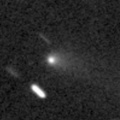
|
Now it is 16.0 mag (Oct. 19, Toshihiko Ikemura, Hirohisa Sato). Now it is fading. It stays 13-14 mag for a while. It is observable in excellent condition in the Southern Hemisphere. It locates somewhat low in the Northern Hemisphere.
Date(TT) R.A. (2000) Decl. Delta r Elong. m1 Best Time(A, h)
Nov. 12 22 28.56 -22 19.8 2.286 2.659 101 17.2 20:17 (124, 69)
Nov. 19 22 33.65 -21 15.3 2.415 2.698 95 17.4 20:26 (114, 63)
|
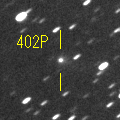
|
It brightened up to 15.3 mag in last winter (Jan. 12, H. Nohara). Now it is fading. It has already faded down to 17.4 mag (Nov. 5, Ken-ichi Kadota). It will be observable at 17 mag in good condition in next winter. It locates low in the Southern Hemisphere.
Date(TT) R.A. (2000) Decl. Delta r Elong. m1 Best Time(A, h)
Nov. 12 10 10.43 18 38.6 4.396 4.359 81 17.2 3:12 (233, 16)
Nov. 19 10 14.62 18 55.2 4.304 4.375 87 17.2 3:04 (230, 18)
|

|
Now it is 19.8 mag (Oct. 7, J. L. Virlichie, P. Traverse, H. Roy, G. Houdin). It will approach to Sun down to 0.1 a.u. on Jan. 31. In the Northern Hemisphere, it will appear in the morning sky at 9 mag in mid February, then it stays observable while the comet will be fading. In the Southern Hemisphere, it stays observable for a long time, although it is not observable from mid January to mid February.
Date(TT) R.A. (2000) Decl. Delta r Elong. m1 Best Time(A, h)
Nov. 12 18 9.16 -48 12.8 2.297 1.791 47 17.5 20:17 ( 50, 30)
Nov. 19 18 19.52 -47 36.4 2.261 1.687 43 17.2 20:26 ( 48, 25)
|

|
It brightened up to 14.2 mag in 2021 summer (July 18, 2021, Taras Prystavski). Now it is fading. It has already faded down to 16.7 mag (Oct. 31, ATLAS South Africa). In the Southern Hemisphere, it stays observable in good condition for a long time. It locates somewhat low in the Northern Hemisphere.
Date(TT) R.A. (2000) Decl. Delta r Elong. m1 Best Time(A, h)
Nov. 12 1 27.92 -25 3.1 4.974 5.673 131 17.2 22:02 (180, 80)
Nov. 19 1 24.12 -24 22.4 5.082 5.717 125 17.3 21:30 (180, 79)
|
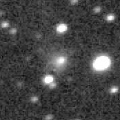
|
Now it is 17.3 mag (Oct. 19, Toshihiko Ikemura, Hirohisa Sato). It stayed bright for a while even after the perihelion passage, but it will be fading after this. It will be fainter than 18 mag in winter.
Date(TT) R.A. (2000) Decl. Delta r Elong. m1 Best Time(A, h)
Nov. 12 21 13.26 -1 29.6 7.242 7.326 90 17.3 20:17 (126, 42)
Nov. 19 21 13.46 -2 6.6 7.391 7.354 83 17.4 20:26 (117, 36)
|
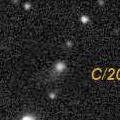
|
It stays 17 mag and observable in good condition for a long time until 2023 summer.
Date(TT) R.A. (2000) Decl. Delta r Elong. m1 Best Time(A, h)
Nov. 12 13 31.92 3 29.5 9.673 8.844 31 17.4 3:12 (276,-14)
Nov. 19 13 33.13 3 31.6 9.607 8.848 37 17.3 3:04 (273,-10)
|
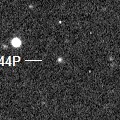
|
Now it is 17.7 mag (Nov. 5, Hirohisa Sato). It is observable at 17 mag in good condition in winter. It locates somewhat low in the Southern Hemisphere.
Date(TT) R.A. (2000) Decl. Delta r Elong. m1 Best Time(A, h)
Nov. 12 6 31.93 26 1.1 3.188 3.920 132 17.4 3:09 (180, 29)
Nov. 19 6 30.11 26 6.1 3.116 3.920 139 17.4 2:40 (180, 29)
|
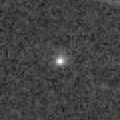
|
Now it is 17.0 mag (Nov. 9, ATLAS South Africa). It stays observable at 17-18 mag until next summer. It may be brighter than this ephemeris.
Date(TT) R.A. (2000) Decl. Delta r Elong. m1 Best Time(A, h)
Nov. 12 21 51.27 -14 45.7 1.577 1.944 95 17.4 20:17 (122, 58)
Nov. 19 21 34.11 -14 9.2 1.710 1.898 84 17.4 20:26 (109, 47)
|
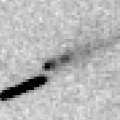
|
It brightened up to 16.1 mag in autumn (Sept. 23, Michael Jager). Then it is fading very rapidly. It has already faded down to 17.9 mag (Oct. 28, Ken-ichi Kadota). It will be getting higher after this also in the Southern Hemisphere.
Date(TT) R.A. (2000) Decl. Delta r Elong. m1 Best Time(A, h)
Nov. 12 10 20.01 7 27.2 1.655 1.697 75 17.4 3:12 (243, 22)
Nov. 19 10 31.83 5 18.5 1.619 1.724 78 17.4 3:04 (243, 25)
|
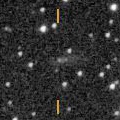
|
Now it is 17.6 mag (Nov. 2, ATLAS-MLO, Mauna Loa). In the Northern Hemisphere, it stays observable at 17 mag in good condition for a long time until winter. In the Southern Hemisphere, it stays extremely low for a long time.
Date(TT) R.A. (2000) Decl. Delta r Elong. m1 Best Time(A, h)
Nov. 12 8 10.58 48 35.2 2.401 2.924 112 17.4 3:12 (196, 4)
Nov. 19 8 14.91 49 4.2 2.356 2.948 117 17.4 3:04 (193, 4)
|
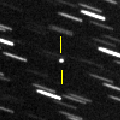
|
It approached to Sun down to 0.14 a.u. on May 15. But it was not observable around that time. In the Northern Hemisphere, it stays observable at 17-18 mag in good condition from July to November. In the Southern Hemisphere, it stays extremely low.
Date(TT) R.A. (2000) Decl. Delta r Elong. m1 Best Time(A, h)
Nov. 12 1 31.71 38 43.6 1.336 2.250 150 17.4 22:05 (180, 16)
Nov. 19 1 17.80 36 10.0 1.392 2.276 145 17.6 21:24 (180, 19)
|
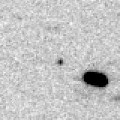
|
Now it is 17.0 mag (Oct. 26, Ken-ichi Kadota). It stays observable at 16 mag for a long time from early 2023 to early 2024. In the Northern Hemisphere, it is observable only until 2023 spring.
Date(TT) R.A. (2000) Decl. Delta r Elong. m1 Best Time(A, h)
Nov. 12 10 33.86 7 41.9 4.852 4.644 72 17.6 3:12 (245, 19)
Nov. 19 10 34.28 6 41.9 4.700 4.608 78 17.5 3:04 (243, 24)
|

|
Now it is 17.4 mag (Oct. 19, Ken-ichi Kadota). It stays observable at 17-18 mag in 2022. It locates somewhat low in the Southern Hemisphere.
Date(TT) R.A. (2000) Decl. Delta r Elong. m1 Best Time(A, h)
Nov. 12 0 55.77 22 40.4 4.722 5.592 148 17.5 21:29 (180, 32)
Nov. 19 0 48.07 21 37.1 4.807 5.607 140 17.6 20:54 (180, 33)
|
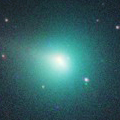
|
It brightened up to 8.8 mag from last winter to early spring (Jan. 31, Chris Wyatt). Now it is fading. Appearing in the morning sky. It will be fainter than 18 mag in December.
Date(TT) R.A. (2000) Decl. Delta r Elong. m1 Best Time(A, h)
Nov. 12 13 39.46 13 10.1 3.784 3.060 37 17.6 3:12 (268,-21)
Nov. 19 13 48.20 12 31.6 3.777 3.106 41 17.7 3:04 (267,-18)
|

|
It brightened up to 12.3 mag from spring to summer in 2021 (June 15, 2021, Marco Goiato). Now it is fading. It will be fainter than 18 mag in January. Recently it is observed extremely faint as 20.8 mag (Oct. 27, Q.-Z. Ye, M. S. P. Kelley).
Date(TT) R.A. (2000) Decl. Delta r Elong. m1 Best Time(A, h)
Nov. 12 12 39.46 30 0.6 6.484 6.040 59 17.6 3:12 (245,-18)
Nov. 19 12 41.32 30 33.4 6.434 6.086 65 17.6 3:04 (243,-14)
|
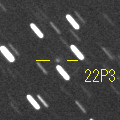
|
Now it is 17.9 mag (Nov. 2, ATLAS-MLO, Mauna Loa). In the Northern Hemisphere, it is observable at 17-18 mag in excellent condition in autumn. It is not observable in the Southern Hemisphere.
Date(TT) R.A. (2000) Decl. Delta r Elong. m1 Best Time(A, h)
Nov. 12 8 19.30 57 20.9 2.291 2.804 111 17.8 3:12 (194, -5)
Nov. 19 8 25.46 60 23.2 2.266 2.835 115 17.8 3:04 (191, -7)
|
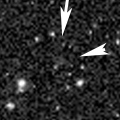
|
Now it is 17.4 mag (Oct. 28, ATLAS Chile). Very far object. It stays 18 mag for a long time from 2021 to 2026. In the Southern Hemisphere, it stays observable in good condition for a long time. In the Northern Hemisphere, it is not observable at all.
Date(TT) R.A. (2000) Decl. Delta r Elong. m1 Best Time(A, h)
Nov. 12 8 8.93 -72 37.5 10.668 10.499 77 17.9 3:12 (349, 50)
Nov. 19 8 2.56 -73 24.8 10.656 10.492 77 17.8 3:04 (353, 51)
|
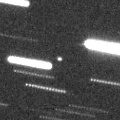
|
Now it is 17.4 mag (Oct. 23, Toshihiko Ikemura, Hirohisa Sato). In 2022, it stays observable at 17 mag for a long time.
Date(TT) R.A. (2000) Decl. Delta r Elong. m1 Best Time(A, h)
Nov. 12 8 26.84 19 37.4 0.787 1.415 104 17.9 3:12 (211, 29)
Nov. 19 8 26.68 19 15.7 0.785 1.475 111 17.9 3:04 (206, 32)
|
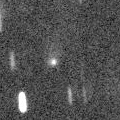
|
Now it is 17.9 mag (Oct. 19, Toshihiko Ikemura, Hirohisa Sato). It started fading before the perihelion passage. It was predicted to stay at 16 mag for a long time. But actually, it will be fainter than 18 mag soon. In the Northern Hemisphere, it stays observable in good condition for a long time. In the Southern Hemisphere, it is not observable until 2023.
Date(TT) R.A. (2000) Decl. Delta r Elong. m1 Best Time(A, h)
Nov. 12 18 17.72 38 46.2 4.341 4.140 71 17.9 20:17 (127,-15)
Nov. 19 18 24.92 36 54.4 4.419 4.166 68 17.9 20:26 (122,-19)
|
|
![]()
 C/2021 G2 ( ATLAS )
C/2021 G2 ( ATLAS ) 61P/Shajn-Schaldach
61P/Shajn-Schaldach C/2021 S3 ( PanSTARRS )
C/2021 S3 ( PanSTARRS ) 285P/LINEAR
285P/LINEAR 408P/2020 M7 ( Novichonok-Gerke )
408P/2020 M7 ( Novichonok-Gerke ) C/2020 S4 ( PanSTARRS )
C/2020 S4 ( PanSTARRS ) (65803) Didymos
(65803) Didymos 77P/Longmore
77P/Longmore C/2021 C5 ( PanSTARRS )
C/2021 C5 ( PanSTARRS ) 44P/Reinmuth 2
44P/Reinmuth 2 C/2020 F5 ( MASTER )
C/2020 F5 ( MASTER ) C/2022 S3 ( PanSTARRS )
C/2022 S3 ( PanSTARRS ) 395P/2020 H1 ( Catalina-NEAT )
395P/2020 H1 ( Catalina-NEAT ) C/2022 E2 ( ATLAS )
C/2022 E2 ( ATLAS ) 246P/NEAT
246P/NEAT P/2021 N2 ( Fuls )
P/2021 N2 ( Fuls ) 204P/LINEAR-NEAT
204P/LINEAR-NEAT 327P/Van Ness
327P/Van Ness C/2022 L2 ( ATLAS )
C/2022 L2 ( ATLAS ) C/2019 O3 ( Palomar )
C/2019 O3 ( Palomar ) 9P/Tempel 1
9P/Tempel 1 402P/2020 Q3 ( LINEAR )
402P/2020 Q3 ( LINEAR ) 96P/Machholz 1
96P/Machholz 1 C/2019 F1 ( ATLAS-Africano )
C/2019 F1 ( ATLAS-Africano ) C/2019 T3 ( ATLAS )
C/2019 T3 ( ATLAS ) C/2020 F2 ( ATLAS )
C/2020 F2 ( ATLAS ) 244P/Scotti
244P/Scotti C/2022 Q2 ( ATLAS )
C/2022 Q2 ( ATLAS ) 157P/Tritton
157P/Tritton C/2021 QM45 ( PanSTARRS )
C/2021 QM45 ( PanSTARRS ) (3200) Phaethon
(3200) Phaethon C/2022 A3 ( Lemmon-ATLAS )
C/2022 A3 ( Lemmon-ATLAS ) C/2020 U4 ( PanSTARRS )
C/2020 U4 ( PanSTARRS ) 19P/Borrelly
19P/Borrelly C/2020 J1 ( SONEAR )
C/2020 J1 ( SONEAR ) C/2022 P3 ( ZTF )
C/2022 P3 ( ZTF ) C/2019 E3 ( ATLAS )
C/2019 E3 ( ATLAS ) 107P/(4015) Wilson-Harrington
107P/(4015) Wilson-Harrington C/2020 U5 ( PanSTARRS )
C/2020 U5 ( PanSTARRS )![]()

































































